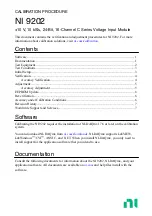
Rev. 6/21/2019
LLW-PAILD, MANUAL
Copyright 2019 Vestil Manufacturing Co.
Page
7
of
9
carrier. If the pail has a handle, tape or otherwise secure
the handle to the side of the pail.
NOTE:
The pail should
be sealed, i.e. lid secured to the top.
a. [LLW-PAILD-100] Close the carrier and latch it by
seating the U-bolt in the latch hook and pressing the
latch lever down.
b. [LLW-PAILD-200] Wrap the strap around the pail
and reattach the hook to the catch on the opposite
end of the carrier. Pull up on the release lever and
hold it. Fold the ratchet together and let go of the
release lever. Now move the handle back-and-forth
to tighten the strap around the pail. To avoid
breaking the pail, DO NOT overtighten the strap!
Step 5: Lift the pail just a few inches above the ground.
Confirm that the pail is secure in the carrier, i.e. cannot
spin or slide up-and-down. If the pail is secure, push the
lifter to the desired location
Step 6: Lock the caster brakes (LLW-PAILD-100) and
raise the pail to the necessary dumping height by turning
the winch handle clockwise. Rest the handle on the winch
mounting bracket. See appropriate
U
Step 7
U
: Grasp the carriage handle and pull up on the carriage lock lever. When the lever unseats from the sprocket,
the carriage is able to rotate. Rotate the drum as needed and release the lock lever. [
NOTE:
Always dump away from
the lifter.] Adjust the dumping angle as necessary by unlocking, repositioning, and re-locking the carriage. There are 9
locking positions between vertical and 135° forward rotation).
Step 8: To remove the pail from the carrier, reorient them to vertical position. Lower the pail to a few inches above the
ground and move the lifter to the appropriate location. Lower the pail to the ground. Unlatch the carrier [LLW-PAILD-
100] or release the ratchet strap [LLW-PAILD-200]. See
Step 9: Lower the deck until it is a few inches above the legs and return the lifter to its storage location. Engage the
brakes (if equipped with optional brakes) and lower the deck completely. Store the lifter in a dry, indoor location.
RECORD OF SATISFACTORY CONDITION (THE “RECORD”)
Record the condition of the hand truck before putting it into service. Thoroughly photograph the unit from multiple
angles so that all operating mechanisms are clearly visible. Take close range photographs of the labeling applied to
the truck. Raise and lower the deck. Describe the operation of the winch. Describe sounds heard as the deck rises
and descends. Include detailed descriptions about the frame, rollers, wheels, casters, carriage, mast rollers, and the
lifting mechanisms (winch, cable, and pulleys). How much effort is required to turn the winch? Apply the brake.
Photograph the brake. Try to move the truck with the brake applied and describe how the brake resists movement.
Collate all photographs and writings into a single file. Give the file a name that clearly identifies it. This file is a record
of the unit in satisfactory condition. Compare the findings of all inspections to the record to determine whether the
truck is in satisfactory condition. Purely cosmetic changes, like damaged paint/powder coat are not changes from
satisfactory condition. However, touch-up paint to be applied to all affected areas as soon as damage occurs.
INSPECTIONS & MAINTENANCE
Regular inspections and maintenance are necessary to keep the device in normal condition. Compare the results
to determine whether the unit is satisfactory condition or requires repairs or
replacement parts. If you are uncertain whether a part requires repair or replacement, contact
for
assistance.
•
Periodically lubricate moving parts.
•
Keep the product clean and dry.
•
Only use manufacturer-approved replacement parts.
At least once every 2 weeks, visually inspect the following components
:
1. Winch, winch mounting bracket, cable, carriage rollers, and pulley (see
Raising and lowering the carriage
Cycle the carriage up and down. Listen for unusual noises and watch for binding or rough movement as the
carriage moves. If the carriage does not move smoothly or makes noise as it moves up or down the upright, apply
a silicon wax or silicon spray to the inside of the mast frame. Examine the winch. Make sure that the spool is
intact and rotates smoothly when the handle is turned. Inspect the mounting bracket. The winch should be solidly
Carriage
lock lever
Carriage handle
Sprocket
Carrier
(back side)
Carrier (front side)
or ratchet strap



























